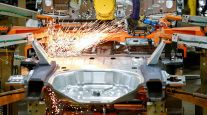OEMs Detail Design Innovations To Meet New Greenhouse Rules
This story appears in the Aug. 22 print edition of Transport Topics. Click here to subscribe today.
Truck and engine makers last week outlined some of the engineering innovations they will have to develop and put onto highways over the next six years to meet recently unveiled federal heavy-truck greenhouse-gas regulations.
They said meeting the new fuel-use standards would be a process of corralling myriad small savings from numerous design changes that, molded together cohesively, will yield 20% reductions in fuel burned and carbon dioxide emitted by the nation’s heavy-duty truck fleet.
With no large, obvious, single solution to the problem, engineers said they will work to combine the benefits of improved aerodynamics, weight reduction, materials science, petroleum chemistry, software and sensors, mechanical and electrical engineering and waste-heat recovery.
“We’re measuring our improvements in tenths of a percent, probably not full percentage points,” said David Hames, general manager of marketing and strategy for Daimler Trucks North America. “The challenge is to show our customers the benefit of aggregating these improvements into packages,” he said.
President Obama announced the new fuel-efficiency standard on Aug. 9. The regulations, developed by the Environmental Protection Agency and the National Highway Traffic Safety Administration, set different targets for various truck sizes and applications, with nonmandatory targets beginning in 2014 and mandatory fuel-use cuts of 20% by 2017 (8-15, p. 1).
“It’s going to take a lot of engineering effort and spending on research and development . . . but the good thing is that, unlike the recent emissions changes [on nitrogen oxides and particulate matter], fleets will see obvious benefits this time in terms of better fuel economy,” said Ramin Younessi, group vice president of product development and business strategy for Navistar Inc.
On the road to 2017, the first checkpoint for truck makers will be 2014.
“For 2014, no truck models will be discontinued or changed radically,” said Younessi, adding that a application of best practices such as the incremental improvements would meet the first set of standards. “But 2017 will be harder,” Younessi said, adding that truck designs may take a radical leap and end up looking like “Japanese bullet trains.”
Daimler’s Hames said engineers will sculpt trucks subtly to minimize every aspect of wind resistance, including tighter-fitting bumper closures, skirts and fairings on tractors and trailers, roof deflectors and tractor side deflectors. Younessi also said that active fifth wheels could tighten the tractor-trailer gap on the highway but loosen it for city driving.
Hames said better engine oils and axle lubricants can boost mileage by reducing friction. The less energy it takes to move drivetrain components, the more efficient a vehicle becomes.
If 5W engine oils replace the 10W variety as an industry standard, it will help efficiency, Hames said.
Shell Lubricants recently said advances in synthetic oil design enable the manufacturer to reduce viscosity while maintaining protection against metal wear.
Part of the research will be underwritten by the Department of Energy through its SuperTruck program, which promotes research into trucking equipment that could be 50% more efficient and marketable by 2015.
Volvo Group’s North American trucking operations, including Volvo Trucks, Mack Trucks and Volvo Powertrain, will receive $19 million from DOE, the company said Aug. 15.
“We appreciate the Department of Energy’s recognition of Volvo as a global technology leader,” said Volvo Powertrain President Peter Karlsten.
With the DOE grant, Karlsten said, “We’re able to explore some planned fuel-efficiency improving technologies earlier in our product development cycle than normally scheduled — and also investigate advanced technologies that normally would not be economically feasible.”
Volvo and Mack said research areas include advanced fuel injection and combustion strategies, advanced materials and lighter-weight vehicle concepts, reduction of tire rolling resistance and reducing engine idling.
Navistar also is a SuperTruck participant, Younessi said, and is working with trailer-maker Wabash National Corp. Improvements in trailer design will not count toward meeting the 2017 greenhouse-gas standard for tractors and their engines, but fleet buyers will enjoy the benefits of more aerodynamic trailers, Younessi said.
Software becomes important, Hames said, in selective use of power — for example in variable-speed fans using sensors to turn the fans on and off as needed, rather than running constantly. That way, fans work only as hard as needed.
Independent engine maker Cummins Inc. said it would prepare a response at a future date soon, but had not done so by press time for this issue. Paccar Inc. and its Kenworth Trucks and Peterbilt Motors operating companies did not respond to requests for comment.
A particularly intriguing challenge is capturing waste heat from engines’ internal combustion. CEOs Martin Daum of DTNA and Daniel Ustian of Navistar have both spoken on the importance of this. Both Hames and Younessi said a sort of hybrid system to turn heat into electricity for in-cab use would be ideal.




